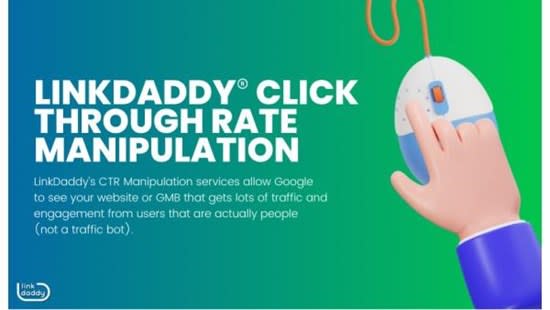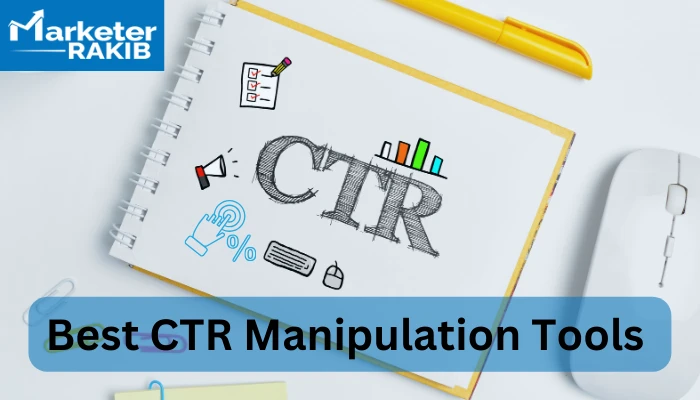CTR Manipulation Press Release: Elevating Online Exposure Through Targeted CTR Methods
Wiki Article
Maximize Your Marketing Initiatives With Strategic CTR Adjustment
The concept of making best use of advertising and marketing initiatives through critical click-through rate (CTR) adjustment offers a nuanced method to boosting audience engagement. By recognizing the psychological triggers that urge users to click, as well as the value of customized web content and design, marketing experts can considerably boost their campaign outcomes.Recognizing Click-Through Rates
Click-through rate (CTR) functions as a crucial statistics in electronic advertising and marketing, representing the portion of individuals that click a certain link out of the total amount who see a web page or ad. This efficiency indicator is vital for analyzing the efficiency of on-line projects, as a greater CTR usually shows that the content resonates well with the target market.Comprehending CTR entails assessing numerous variables, including the importance of the material, the positioning of links, and the total customer experience. A well-crafted call-to-action (CTA) can dramatically affect CTR, encouraging individuals to involve better with the material offered - CTR Manipulation Press Release. Additionally, the layout and visual appeals of an advertisement or website play a crucial role in catching interest and prompting clicks

Mental Triggers for Interaction
Interaction in digital advertising relies heavily on comprehending emotional triggers that encourage users to connect with material. Different psychological responses and cognitive biases can considerably influence user habits, resulting in greater involvement prices and improved click-through rates (CTR)One trick mental trigger is the principle of scarcity. They are extra most likely to take immediate action when customers regard that an offer is restricted in time or schedule. Likewise, social evidence, such as endorsements or user-generated content, can create a feeling of count on and recognition, motivating customers to involve more readily.
One more powerful trigger is making use of interest. Igniting a customer's passion with intriguing headlines or visuals can compel them to look for more details. Furthermore, leveraging the principle of reciprocity-- offering beneficial web content in exchange for customer communication-- can promote a feeling of obligation to involve.
Psychological allures additionally play a vital role; web content that stimulates sensations of anxiety, surprise, or joy can drive users to link and react. By effectively harnessing these emotional triggers, marketing experts can create an engaging story that encourages user engagement and optimizes their marketing efforts.
Strategies for CTR Control
To improve click-through rates (CTR) effectively, marketing experts can employ a range of strategies developed to catch individual attention and encourage interaction. One essential technique is maximizing headlines and meta summaries. Crafting engaging, benefit-driven titles that resonate with the target audience can substantially enhance the likelihood of clicks.Look At This Furthermore, utilizing visuals such as photos or videos can significantly improve engagement. Appealing graphics that are pertinent to the material can produce a more powerful charm and draw individuals in. Implementing A/B testing is one more powerful strategy; by try out various variations of ad copy, visuals, and call-to-action switches, marketing professionals can identify which aspects produce the greatest CTR.
An additional reliable technique read is integrating necessity and scarcity into advertising and marketing messages. Expressions like "minimal time deal" or "just a couple of left" can create a sense of urgency, triggering individuals to act swiftly. Customization also plays a critical duty; tailoring material to meet the certain requirements and preferences of your audience can foster a deeper connection, additional enhancing CTR.
Measuring and Evaluating CTR Success
Measuring and evaluating CTR success includes a methodical approach to assess the effectiveness of marketing techniques implemented to increase user communications. To achieve this, marketing experts need to first develop clear goals and key performance indicators (KPIs) pertaining to CTR. These KPIs might consist of total click-through prices, conversion rates, and user involvement metrics.Data collection is a critical action in this process. Making use of analytics tools, marketing professionals can gather information on individual actions, consisting of which aspects of a campaign are driving clicks and which are not. Segmenting the information by demographics, tool types, or traffic resources permits much deeper understandings right into specific target market preferences and engagement patterns.
Once data is collected, comprehensive analysis must be carried out to recognize patterns and relationships. Employing A/B screening can further enhance this process by contrasting various versions of advertisements or landing web pages to establish which does much better. In addition, assessing the effect of outside aspects, such as seasonality or sector modifications, gives context for CTR changes.
Ultimately, the goal is to derive workable understandings that inform future advertising and marketing methods, making sure that initiatives are continuously fine-tuned to maximize customer involvement and conversion possibility. CTR Manipulation Service.
Ideal Practices for Optimization
Efficient optimization of click-through rates (CTR) needs a tactical technique that incorporates finest practices tailored to the specific goals of a marketing project. First, it is necessary to craft appropriate and engaging ad duplicate that resonates with the target audience. Utilizing clear calls-to-action (CTAs) can substantially enhance customer interaction, motivating potential clients to click.This data-driven method permits marketing experts to identify which aspects generate the greatest CTR, allowing continual renovation. Guaranteeing advertisements and touchdown pages are mobile-friendly can dramatically enhance CTR.

Final Thought

Understanding CTR includes evaluating different factors, consisting of the significance of the material, the positioning of web links, and the general customer experience. A well-crafted call-to-action (CTA) can dramatically affect CTR, encouraging customers to involve additionally with the material presented. By concentrating on maximizing CTR, marketers can refine their approaches, guaranteeing that their digital advertising efforts yield maximum interaction and drive preferred outcomes.To boost click-through prices (CTR) efficiently, marketing professionals can utilize a range of techniques designed to catch customer focus and urge communication (GMB CTR Manipulation).Analyzing and gauging CTR success entails a systematic technique to examine the efficiency of advertising methods implemented to increase customer communications
Report this wiki page